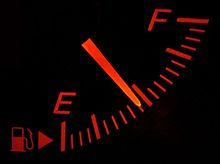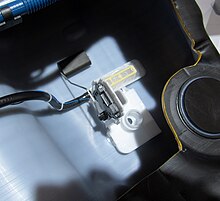Fuel gauge
The fuel gauge , and fuel gauge , fuel gauge or fuel gauge called to the still available to drive an estimate fuel storage permit. For this purpose, a display instrument is positioned in the driver's field of vision , which usually informs the driver with an analog pointer between the marks full and empty, with tick marks for quarter, half and three-quarters filling and a mostly red marking for reserve . Often a (mostly yellow) lamp is also installed if the fuel supply is running low. The supply can also be displayed in liters.
An analog sensor must be integrated inside the fuel tank for the display . Earlier it was a filled with air, soldered brass - float , which was rotatably supported on an axis. By means of a reversing lever, the fuel level was mechanically transmitted with a Bowden cable to a pointer instrument on the dashboard ( VW Beetle of the 1960s).
Today tanks carry a float tube with a plastic float , the vertical level of which changes an electrical resistance . This resistance is measured by the display instrument and the corresponding fill level is displayed, mostly in today's instrument cluster . A common standard size is 240–33 ohms , 240 when the tank is full and 33 when the tank is empty. In addition to these passive fuel sensors, there are also active fuel sensors that output a variable voltage . Attention must be paid to explosion protection during construction.
Another variant used today uses flow sensors to measure the amount of fuel that is added and removed and uses this to calculate the current level. However, since a fill level is never actually measured, such systems tend to produce errors that the device cannot detect by itself. It can happen that the sensor on the filler neck does not work with all fuel nozzles and an incorrect or no amount of fuel is measured. The result is that the fuel gauge shows “empty” for the remainder of the tank filling and it is impossible to tell when the tank is actually empty.
Some earlier vehicles did not have a fuel gauge (VW Sparkäfer until 1966). Instead, a fuel valve , usually switchable by foot, was mounted at the bottom of the tank outlet ( reserve tap ): During normal driving, the fuel is drained from a tube at a height of a few centimeters; after switching, the level below the tube is still available for a few kilometers to continue driving. This type of tube is still common today on mopeds and motorcycles without a fuel gauge and is easily integrated into the fuel valve under the tank, which has a third swivel position for this purpose.
There was also the possibility (Trabant until 1990) to check the fuel content quite trivially with a dipstick.
Accumulator status display
In English usage, the fuel gauge is referred to as "fuel gauge". In electronics, there are circuits for indicating the charge level of accumulators, which are also referred to as "fuel gauge": They show the charge level of the accumulator like a fuel gauge.
Individual evidence
All in English!

